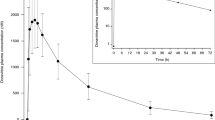Abstract
Purpose
The clinical efficacies of some antiretroviral drugs are known to not depend on its concentration in blood. To establish a method of dosage adjustment for darunavir (DRV) based on pharmacokinetic theory, we analyzed the correlation between DRV levels in peripheral blood mononuclear cells (PBMCs) and plasma.
Methods
The concentrations of DRV and ritonavir (RTV) in plasma and PBMCs of 31 samples obtained from 19 patients were analyzed. An in vitro kinetic study using MOLT-4 cells was performed to assess the contribution of RTV to the intracellular accumulation of DRV.
Results
DRV levels in PBMCs varied between 7.91 and 29.36 ng/106 cells (CV 37.5%), while those in plasma were greater. No significant correlation was found between the trough level of DRV in plasma and that in PBMCs (p = 0.575). The inter-day difference in DRV levels in PBMCs seemed smaller than that in plasma (− 41.6–23.0% vs − 83.3–109.1%). In the in vitro study, the elimination half-life of cellular efflux of DRV was 15.7 h in the absence of RTV and extended to 47.6 h in the presence of RTV.
Conclusions
We found a poor correlation between intracellular DRV and plasma DRV levels in patients receiving highly active antiretroviral therapy. The efflux rate of DRV from cells was slow; therefore, the concentration of DRV in PBMCs may reflect average exposure to the drug and clinical efficacy.




Similar content being viewed by others
References
Surleraux DL, Tahri A, Verschueren WG, Pille GM, de Kock HA, Jonckers TH et al (2005) Discovery and selection of TMC114, a next generation HIV-1 protease inhibitor. J Med Chem 48:1813–1822
De Meyer S, Azijn H, Surleraux D, Jochmans D, Tahri A, Pauwels R et al (2005) TMC114, a novel human immunodeficiency virus type 1 protease inhibitor active against protease inhibitor-resistant viruses, including a broad range of clinical isolates. Antimicrob Agents Chemother 49:2314–2321
Boffito M, Miralles D, Hill A (2008) Pharmacokinetics, efficacy, and safety of darunavir/ritonavir 800/100 mg once-daily in treatment-naïve and -experienced patients. HIV Clin Trials 9:418–427
Soon GH, Shen P, Yong EL, Pham P, Flexner C, Lee L (2010) Pharmacokinetics of darunavir at 900 milligrams and ritonavir at 100 milligrams once daily when coadministered with efavirenz at 600 milligrams once daily in healthy volunteers. Antimicrob Agents Chemother 54:2775–2780
Arab-Alameddine M, Lubomirov R, Fayet-Mello A, Aouri M, Rotger M, Buclin T et al (2014) Swiss HIV Cohort Study. Population pharmacokinetic modelling and evaluation of different dosage regimens for darunavir and ritonavir in HIV-infected individuals. J Antimicrob Chemother 69:2489–2498
Sekar V, De Meyer S, Vangeneugden T, Lefebvre E, De Paux M, Van Baelen B, et al. (2006) Pharmacokinetic/pharmcodynamic (PK/PD) analyses of TMC114 in the POWER 1 and POWER 2 trials in treatment-experienced HIV-infected patients. In: Abstracts of the Thirteenth Conference on Retroviruses and Opportunistic Infections [Abstract]. Foundation for Retrovirology and Human Health 2006; J121
Taiwo B, Zheng L, Gallien S, Matining RM, Kuritzkes DR, Wilson CC et al (2011) Efficacy of a nucleoside-sparing regimen of darunavir/ritonavir plus raltegravir in treatment-naive HIV-1-infected patients (ACTG A5262). AIDS 25:2113–2122
Kakuda T, Sekar V, Vis P, Coate B, Ryan R, Anderson D et al (2012) Pharmacokinetics and Pharmacodynamics of Darunavir and Etravirine in HIV-1-Infected, Treatment-Experienced Patients in the Gender, Race, and Clinical Experience (GRACE) Trial. AIDS Res Treat 2012:186987
Kakuda TN, Brochot A, Tomaka FL, Vangeneugden T, Van De Casteele T, Hoetelmans RM (2014) Pharmacokinetics and pharmacodynamics of boosted once-daily darunavir. J Antimicrob Chemother 69:2591–2605
Nagano D, Araki T, Nakamura T, Yamamoto K (2014) Determination of intracellular darunavir by liquid chromatography coupled with fluorescence detection. J Chromatogr Sci 52:1021–1025
Lee CG, Gottesman MM, Cardarelli CO, Ramachandra M, Jeang KT, Ambudkar SV et al (1998) HIV-1 protease inhibitors are substrates for the MDR1 multidrug transporter. Biochemistry 37:3594–3601
Bachmeier CJ, Spitzenberger TJ, Elmquist WF, Miller DW (2005) Quantitative assessment of HIV-1 protease inhibitor interactions with drug efflux transporters in the blood-brain barrier. Pharm Res 22:1259–1268
Kakuda TN, Sekar V, Lavreys L, De Paepe E, Stevens T, Vanstockem M et al (2014) Pharmacokinetics of darunavir after administration of an oral suspension with low-dose ritonavir and with or without food. Clin Pharmacol Drug Dev 3:346–352
Kakuda TN, Van De Casteele T, Petrovic R, Neujens M, Salih H, Opsomer M et al (2014) Bioequivalence of a darunavir/cobicistat fixed-dose combination tablet versus single agents and food effect in healthy volunteers. Antivir Ther 19:597–606
Sekar V, Kestens D, Spinosa-Guzman S, De Pauw M, De Paepe E, Vangeneugden T et al (2007) The effect of different meal types on the pharmacokinetics of darunavir (TMC114)/ritonavir in HIV-negative healthy volunteers. J Clin Pharmacol 47:479–484
Liu ZL, Onda K, Tanaka S, Toma T, Hirano T, Oka K (2002) Induction of multidrug resistance in MOLT-4 cells by anticancer agents is closely related to increased expression of functional P-glycoprotein and MDR1 mRNA. Cancer Chemother Pharmacol 49:391–397
Author information
Authors and Affiliations
Corresponding author
Ethics declarations
This study was approved by the Institutional Review Board for Clinical Trials at Gunma University Hospital and the Ethics Committee for Human Genome Analysis at Gunma University; all patients gave written informed consent prior to participating in the study.
Conflict of interest
The authors declare that they have no conflicts of interest.
Rights and permissions
About this article
Cite this article
Nagano, D., Araki, T., Yanagisawa, K. et al. Darunavir concentration in PBMCs may be a better indicator of drug exposure in HIV patients. Eur J Clin Pharmacol 74, 1055–1060 (2018). https://doi.org/10.1007/s00228-018-2464-y
Received:
Accepted:
Published:
Issue Date:
DOI: https://doi.org/10.1007/s00228-018-2464-y




